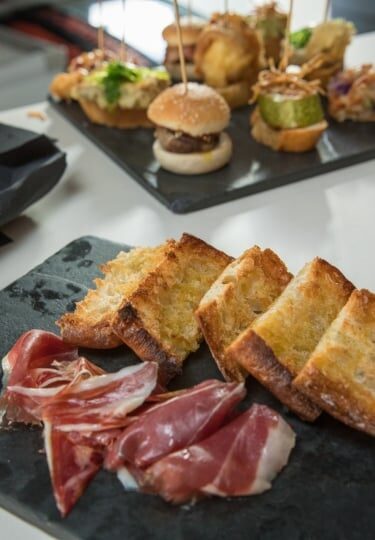Mallorca’s gastronomic scene benefits from an abundance of food sources, some of which come from the sea, others from a long terrestrial tradition of cultivating almonds, apricots, grapes, lemons, olives, oranges, and fresh produce on this Balearic Island.
You’ll also have the opportunity to taste many appetizing soups and robust meat dishes while exploring Mallorca’s bistros, cafés, and restaurants.
You’ll find fresh seafood on menus everywhere, but the real heart of Mallorcan cuisine is meatier. The island produces a fine range of pastries and sweet goods, too. Here is some of the best food in Mallorca to try.
Tumbet
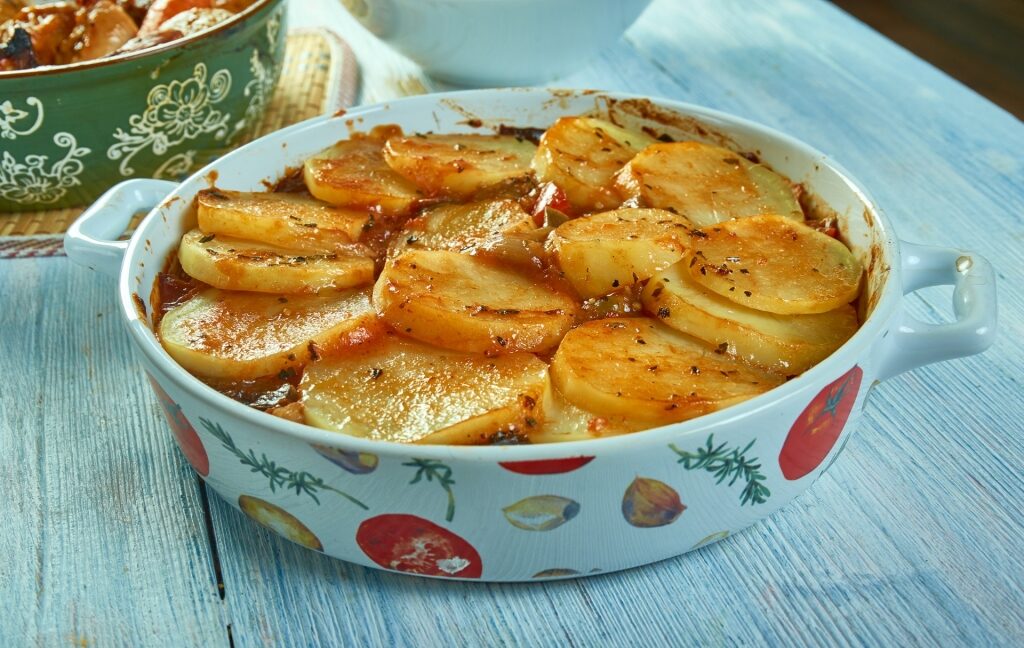
Tumbet
Tumbet is a flavorsome, vegetable-based staple that dates back to the 16th century. This dish, which shares a lineage with France’s famous ratatouille, mixes new world produce like fried eggplants, called aubergines here, potatoes, and tomatoes with garlic, olive oil, and other vegetables.
Found all over this Spanish island, tumbet, also called tombet, is a satiating baked, layered dish that is ideal for vegetarians. Tumbet can be served as a main course, as a side accompanying a larger meal, or can be mixed in with a selection of smaller tapas.
Sobrassada
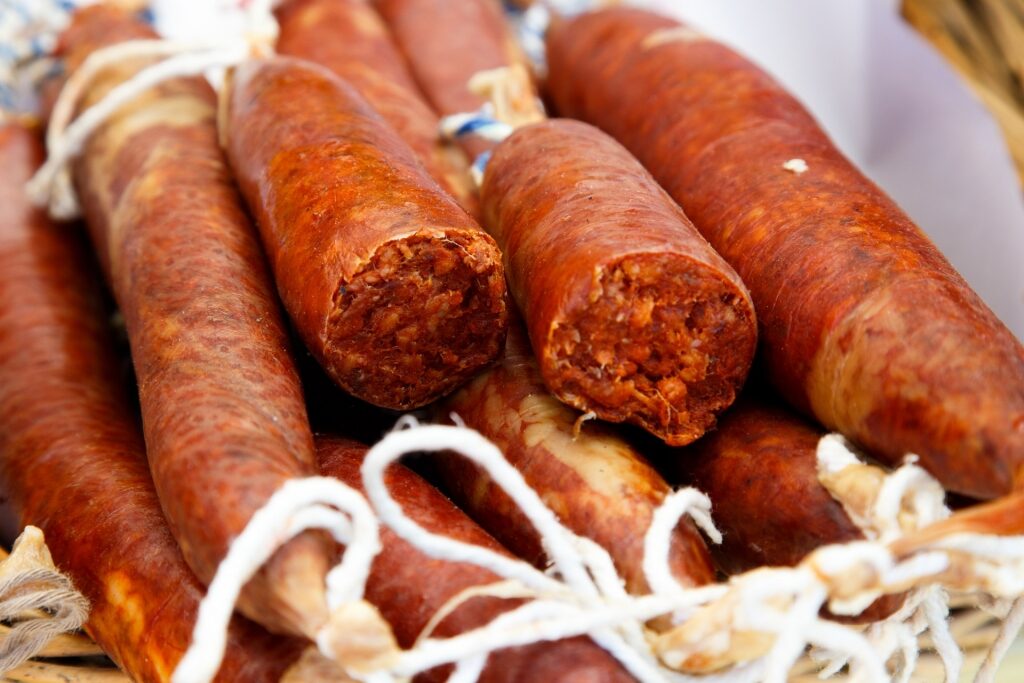
Sobrassada
At the opposite end of the food spectrum when compared to the vegetarian-friendly tumbet, you have Mallorca’s much-celebrated sobrassada. Sobrassada is a cured, spicy chorizo sausage.
When you eat sobrassada, pay attention to how it differs from what most people consider traditional chorizo in several key ways. First off, sobrassada should be made from black pig, or porc negre mallorquí, although you will find versions made from other types of pork.
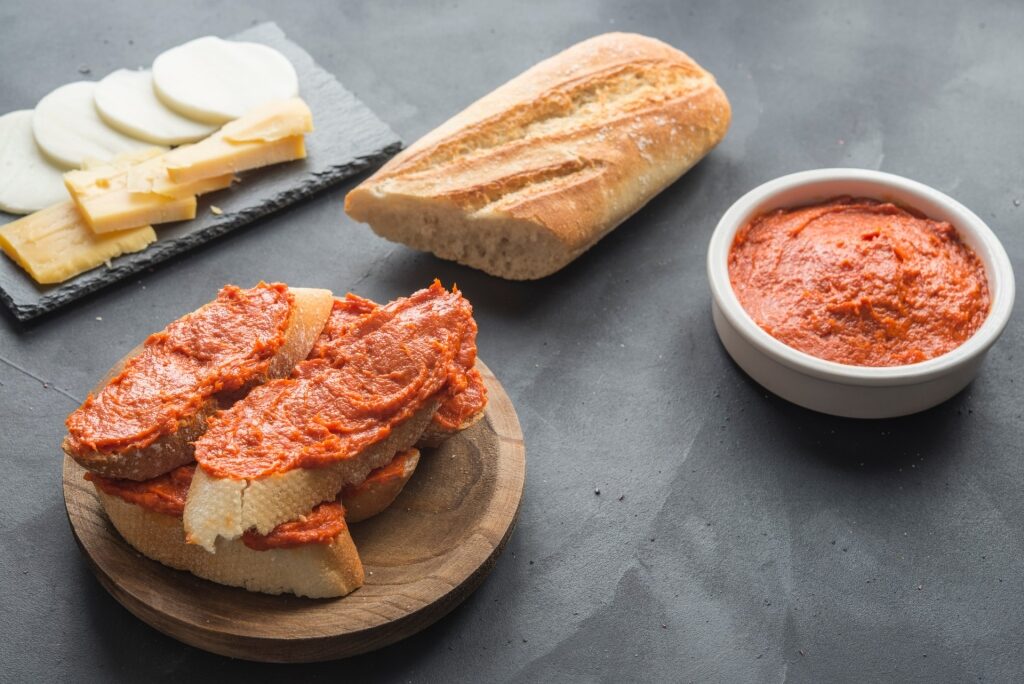
Sobrassada
Next, good sobrassada should get an infusion of heat from paprika, which is typically grown locally on the island. And perhaps sobrassada’s biggest distinction is the fact that it’s usually served as a chorizo spread, or pâté, spread across a big piece of bread. Apricot jam or honey are often layered on top.
You’ll also notice that sobrassada is used as an ingredient in many different recipes, including Lomo con Col, and even as a stuffing in panades, or Mallorcan empanadas. If you fancy trying some sobrassada for yourself, you’ll have no problem finding it, as it’s readily available all over the island.
Panades

Panades
Panades are Mallorcan empanadas. In case you’re not in the know, an empanada is a small fried or baked stuffed pastry turnover, characteristically filled with some kind of meat or cheese, along with a few diced vegetables.

Panades
On Mallorca, panades, circular in shape, are customarily packed with lamb, but you’ll also come across panades filled with sobrassada, chicken, fish, vegetables (generally lots of peas), and other ingredients.
Although available throughout the year, panades come into their own during Easter and other big festivals, when they are devoured en masse.
Rubiols
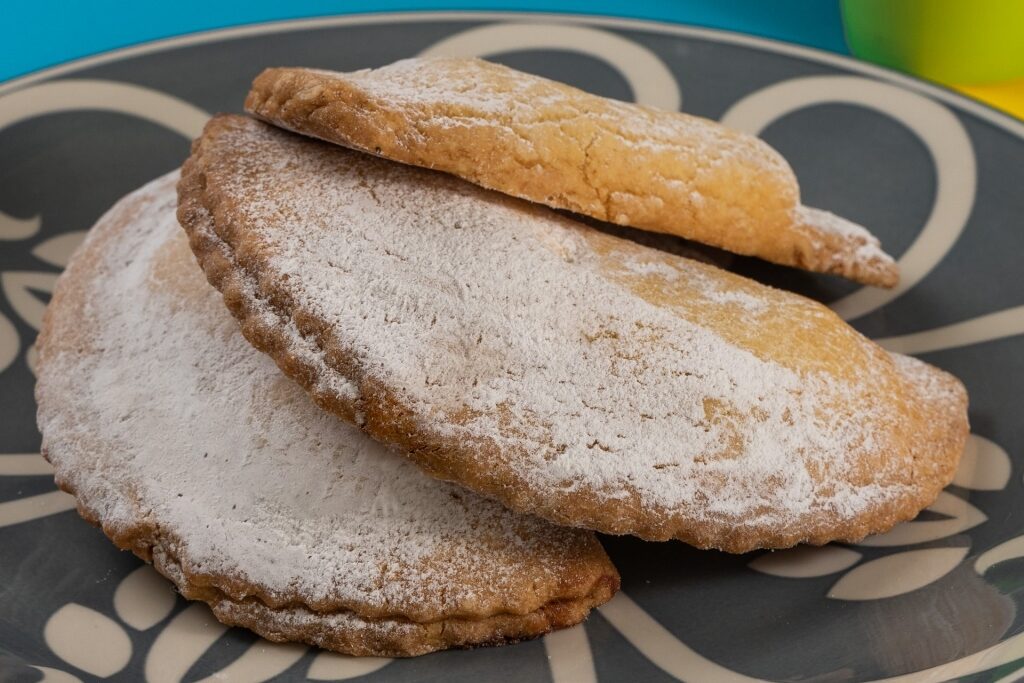
Rubiols
Rubiols, also popular during the holidays, are a much sweeter pastry cousin to savory panades, and are guaranteed to fire off your tongue’s sweet-taste receptors.
This folded snack, classically coming in a half moon shape, is made with sweetened dough and filled with apricot jam, spaghetti squash marmalade, chocolate, or cottage cheese and lemon.
As you indulge in one or several rubiols and relish in their delightful combination of bread and filling, it’s interesting to note that these pastries can likely trace their legacy back to Jewish baking traditions.
Trampó

Trampó
If fresh vegetables brought together in seamless balance appeal to your well-traveled palate, trampó, an ideal dish to order on a sun-filled day, is definitely for you. It’s elegant, simple in nature, and refreshingly tasty.
Traditional trampó is made from Mallorcan-grown produce, including peppers, onions, tomatoes, salt, and olive oil—and that’s it.
The trick is to slice (never dice) the onion, remove all the seeds from the peppers, then bring harmony to this medley of flavors with just the right amount of salt and olive oil. Trampó goes perfectly with a bit of bread or some tortillas.
You can find different variations on the classic recipe, with ingredients like capers, chickpeas, fish, olives, or potatoes thrown into the mix; but if you want to experience this dish in the manner most locals do, your best bet is to stick with the original recipe whenever possible.
Coca Mallorquina
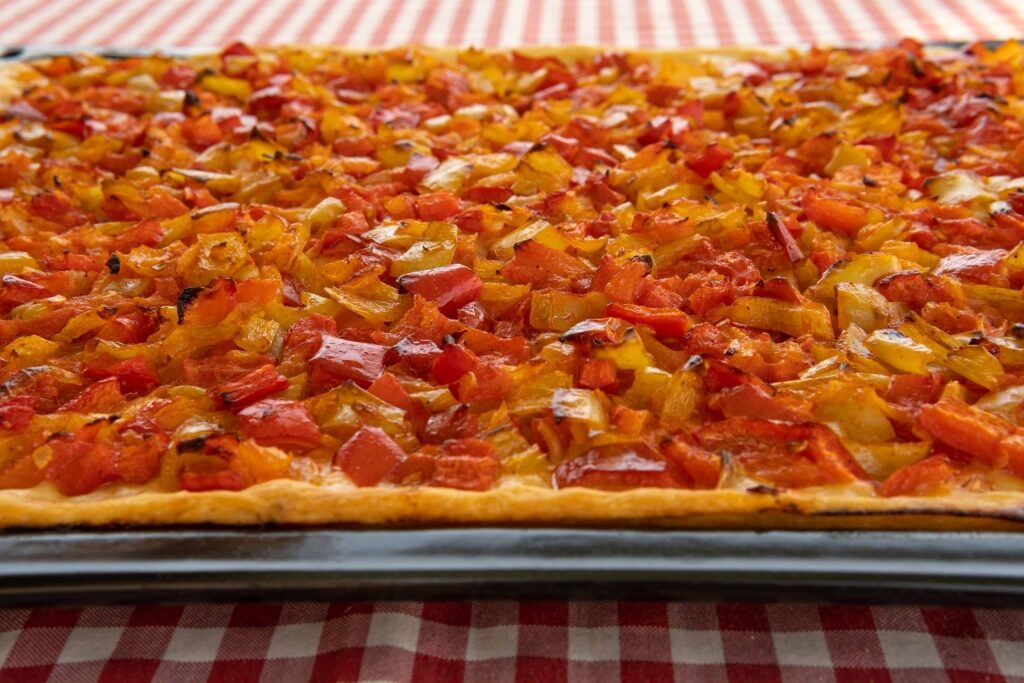
Coca mallorquina
The coca mallorquina red pepper tart, often referred to as coca de trampó, is a crispy, cracker-like flat bread made from simple coca dough that is coated with trampó.
At first glance, this dish looks a little like a pizza. But don’t be fooled; the taste and texture of the baked dough, with trampó spread across the top, is considerably different in flavor than a traditional Italian pizza.
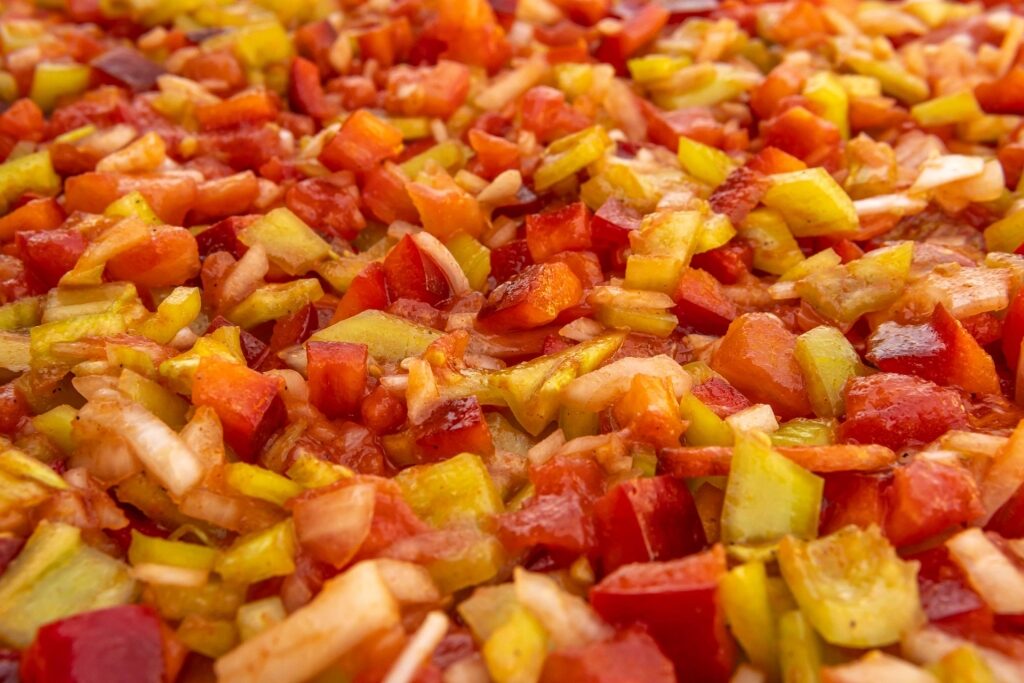
Coca mallorquina
You’ll find variations of coca mallorquina—coming with different toppings, including meat—at different locales across Mallorca. Pretty much every bakery on the island carries some kind of coca mallorquina.
You’ll even find fancier versions, like the ones served at Palma’s Michelin star restaurant Maca de Castro, in the Bistro Garden.
Ensaïmada

Ensaïmada
If your sweet tooth is getting the better of you, tuck into some flaky Balearic ensaïmada while traveling around Mallorca. This light pastry, which comes in a swirl shape, like a snail shell, will go with your morning or afternoon coffee. But don’t fret, as you can find one anytime during the day.
One of the ingredients giving ensaïmada dough its special texture is pork lard—which is good news for baked goods lovers, although bad news for strict vegetarians. Ensaïmada can be filled with angel hair pumpkin jam, chocolate, or cream, and are extremely popular among locals.

Ensaïmada
The history of ensaïmada is somewhat shrouded in mystery. Some theories claim that the pastry was created during Moorish rule (probably without the lard), while another theory claims that a Jewish baker came up with the idea. Either way, it’s an incredibly tempting treat.
Arròs Brut

Arròs brut
Arròs brut is Mallorca’s “dirty” rice. The original take on this nourishing dish was prepared with blood and offal, giving the rice a color that locals jokingly referred to as “dirty.”
Arròs brut, at its core, is a somewhat soupy rice dish made with a hodgepodge of ingredients. The usual suspects include rabbits, all kinds of local vegetables, chicken, paprika, pigeon, snails… and the list goes on.
If you’re after a substantial meal and aren’t too picky about what goes into it, Mallorca’s “dirty” rice could be for you.
Botifarra Negra
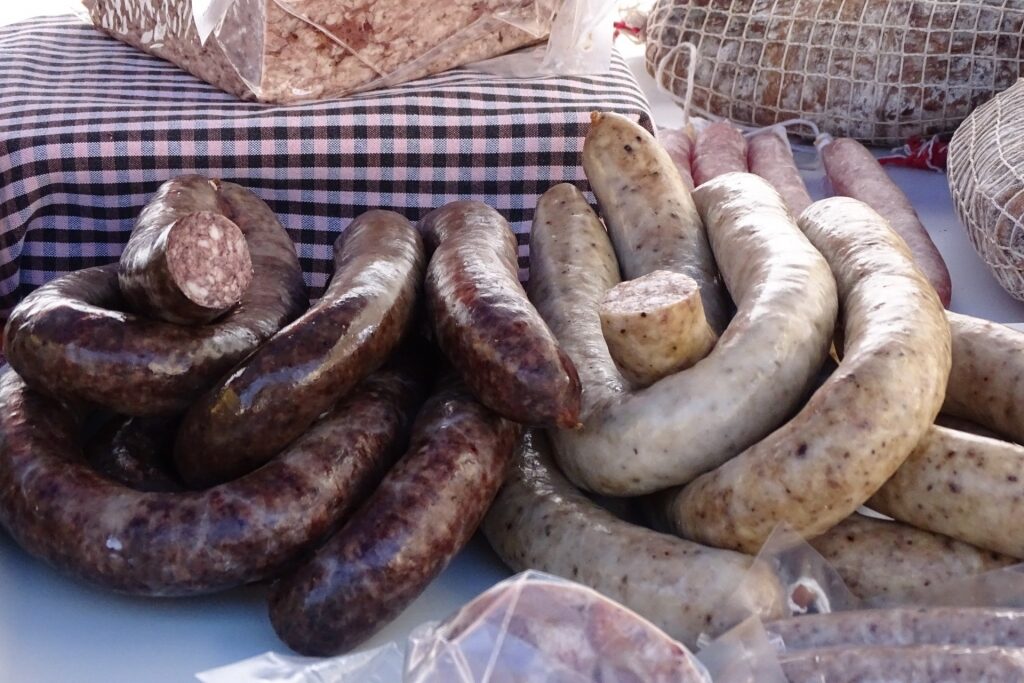
Botifarra negra
You’ll find different types of botifarra sausages all over Catalunya. On Mallorca, botifarra negra, or black botifarra, is made with pork and blood, providing the sausage its distinctive black color. Botifarra negra is often given an extra kick with black pepper, fennel seeds, pine nuts, and other spices.
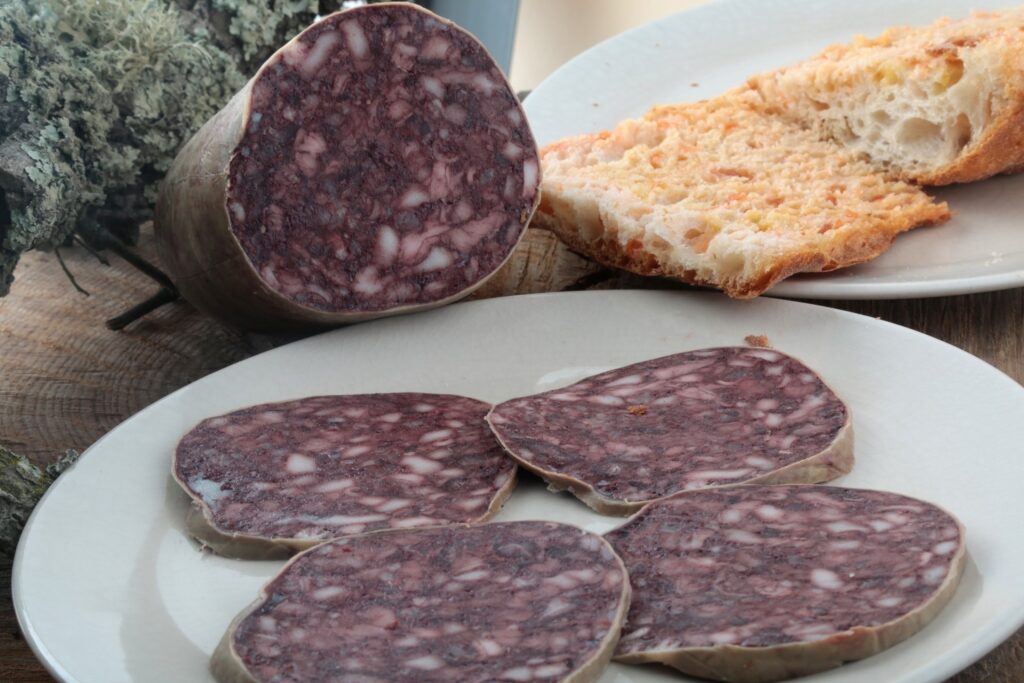
Botifarra negra
The fresh versions of these Mallorcan sausages should be boiled or grilled before you dig into them. Botifarra negra is often added as an ingredient in other local dishes as well.
Cured or cooked botifarras, on the other hand, can be enjoyed as is. If the idea of the blood is a turn-off, ask for white botifarra, which is prepared without any.
Pa Amb Oli
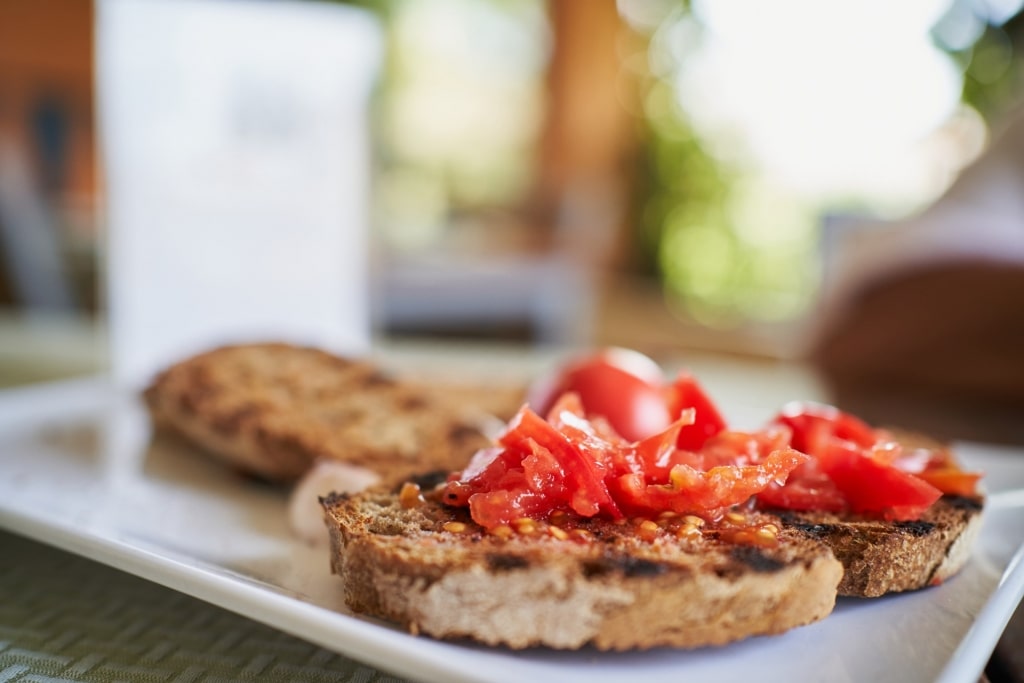
Pa amb oli
Pa amb oli is an unassuming, yet cherished food across Mallorca. It’s so well-loved that this bread and olive oil merienda (a light meal or snack) has been written about in books detailing the island’s culture.
At its heart, pa amb oli is made with sliced pan payés (peasant bread), with local ramallet tomato vigorously scrubbed across the top of the bread. Plenty of olive oil is added on top, along with sea salt flakes.
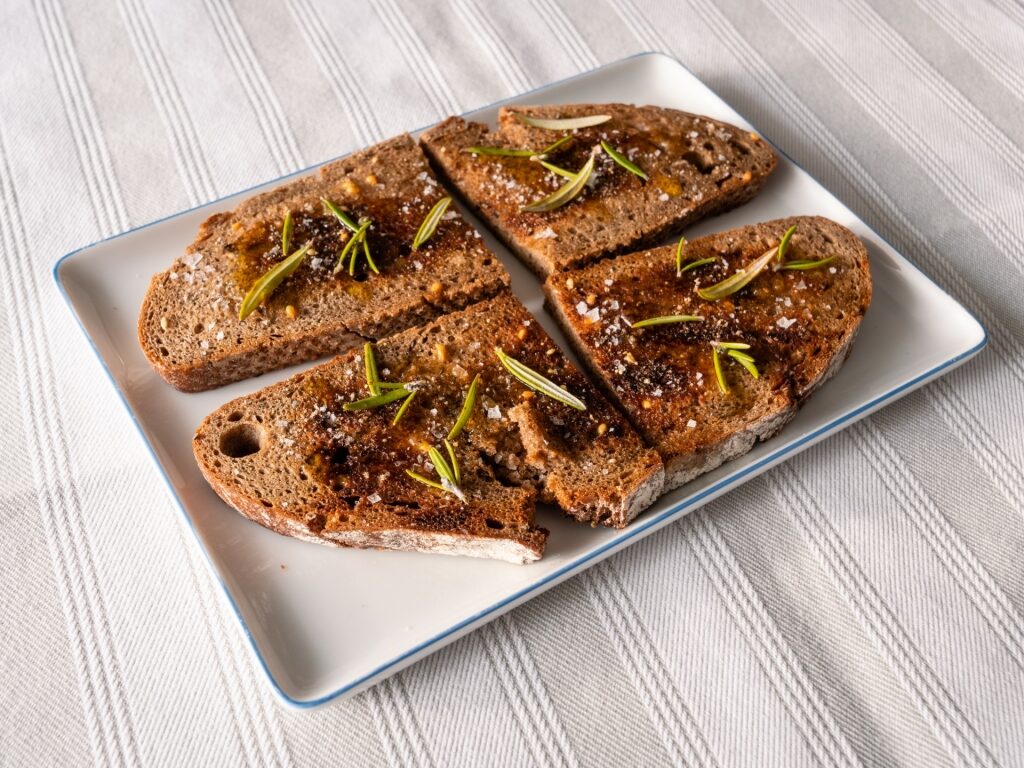
Pa amb oli
Garlic is often rubbed into the bread with the tomatoes. And as is common with many recipes, you’ll find different pa amb oli variations that use brown bread, or add capers, cheese, figs, ham, and so on. It’s a simple but delicious feast.
Cocarrois
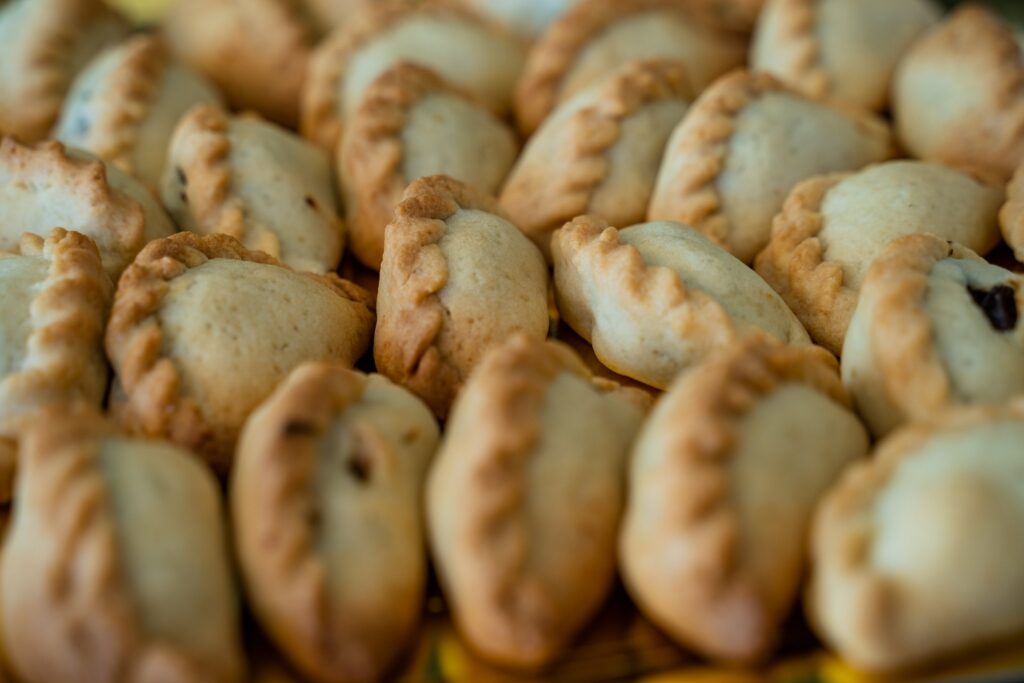
Cocarrois
As you’ve likely noted, Mallorca does not suffer from a shortage of baked goods. Savory cocarrois turnovers are no exception to this rule.
These little crescent-shaped pastries, found in practically every bakery on the island, are delightful little snacks that come with a vegetable, meat, or even seafood stuffing.
Cocarrois share a lot of culinary DNA with panades, although the recipes for cocarrois dough tend to vary some, along with the shape. In appearance, cocarrois look more like Asian dumplings but have a taste all their own.
Hierbas
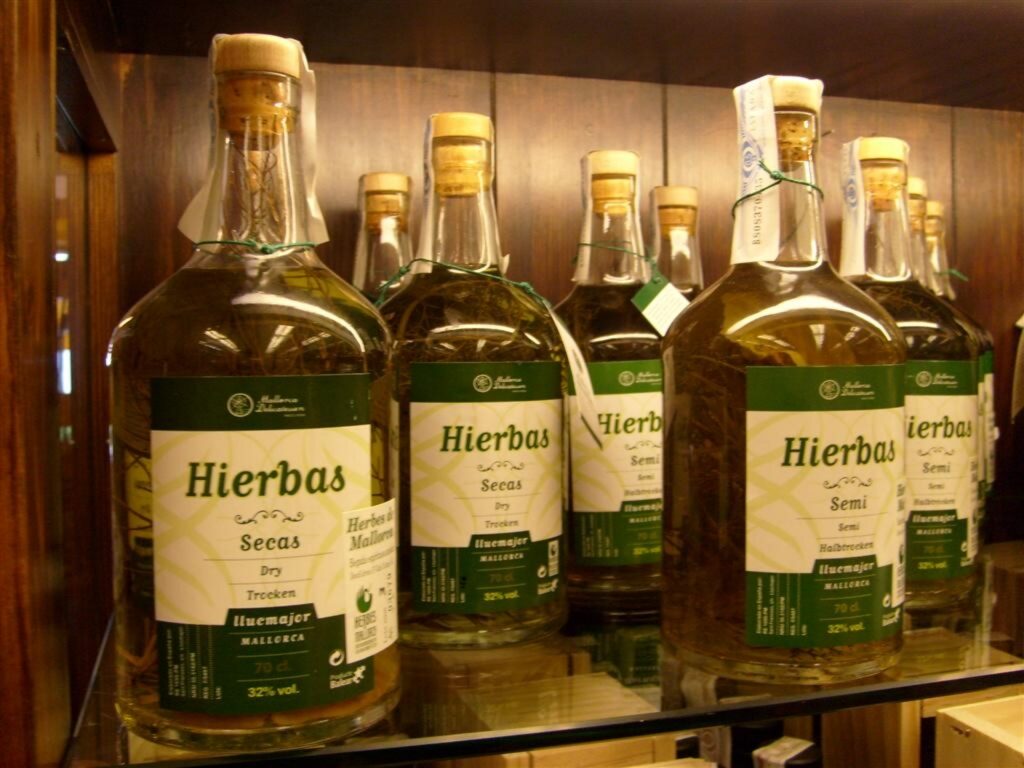
Hierbas Photo by Christian Nurtsch on Wikimedia Commons, licensed under CC BY-SA 2.0 DE
With so much seafood, bread, olive oil, and salt on the menu in Mallorca, you may need something to wash it all down with. Enter Hierbas, an aniseed-based herbal liqueur distinct to the Mediterranean island and also exported elsewhere.
Hierbas, said to help with digestion, comes in different flavors, including fennel, lemon, mint, orange, thyme, and more. Served as a shot, or cold over ice, this powerful digestif—or aperitif if enjoyed before your meal—is bound to add an exquisite grace note to your Mallorcan dining experiences.
Lomo Con Col
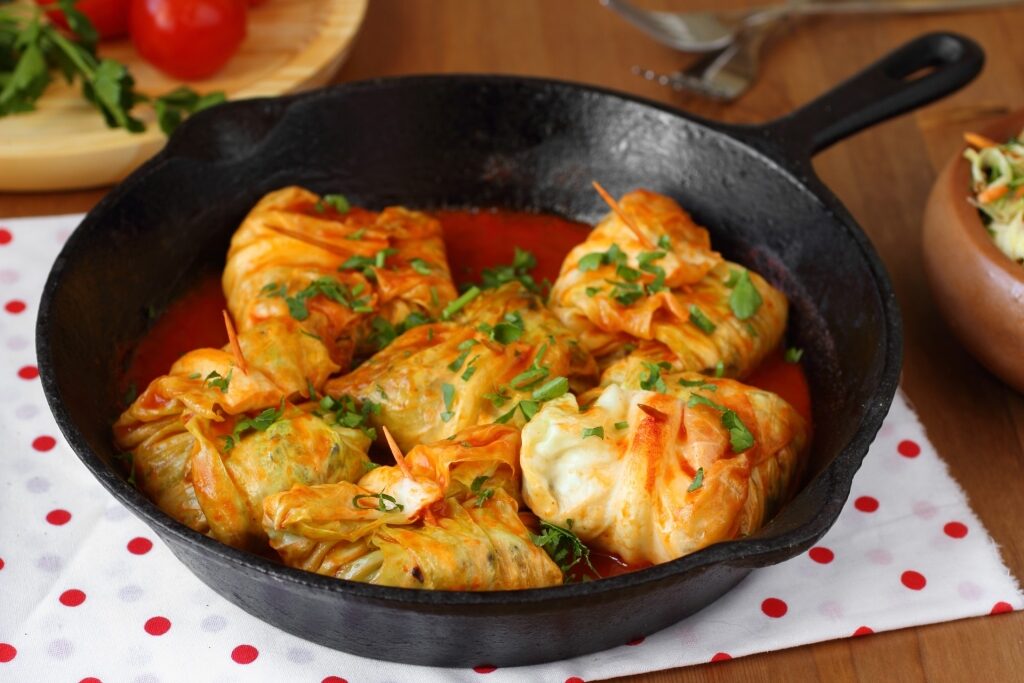
Lomo con col
Lomo con col, also known as lom amb col, are cabbage rolls that integrate pork from Mallorca’s fêted black pig with apricots, pine nuts, raisins, and other ingredients.
This savory pork loin and cabbage dish truly is delicious, and as you can imagine, tender, juicy, and quite filling. If you get the chance to order lomo con col, chances are you won’t need a second helping.
Frito Mallorquín

Frito mallorquín
If fried food is your guilty pleasure, then frito mallorquín is calling your number. This pan-fried “peasant” dish is not for finicky eaters, but it’s certainly an authentic Mallorca food.
Frito mallorquín, with origins going back to the 14th century, is made with diced vegetables and meat—typically lamb or pig kidneys, heart, and liver, plus a laundry list of additional items.

Frito mallorquín
This dish can contain artichokes, cinnamon, fennel, garlic, onions, peas, potatoes, red peppers, spring onions, and other inexpensive, easy-to-find ingredients. You’ll also come across a version that uses chicken livers instead of offal from other animals.
Frito mallorquín can be eaten any time of the day as a main course, or in smaller portions as tapas. Regardless, it’s guaranteed to satiate your appetite with its fried goodness, no matter how ravenous you are.
Gató de Almendra

Gató de almendra
The almendra de Mallorca, or almond of Mallorca, is a popular feature of local cuisine. Sizable chunks of land are devoted to almond trees, their blossom a swathe of pinky-white in early spring.
One of the best ways to enjoy the island’s almond harvest is by carving into a gorgeous slice of gató de almendra, or almond cake.
Gató de almendra is a flaky dessert made with almonds, eggs, ground lemon peel, and sugar. This fluffy, iconic sweet is traditionally given a light covering of powdered sugar and served with a scoop of locally-produced almond ice cream.
Mallorca’s almond cake pairs perfectly with coffee or can be enjoyed on its own on a hot summer day.
Read: Best Beaches in Mallorca
Greixonera de Brossat
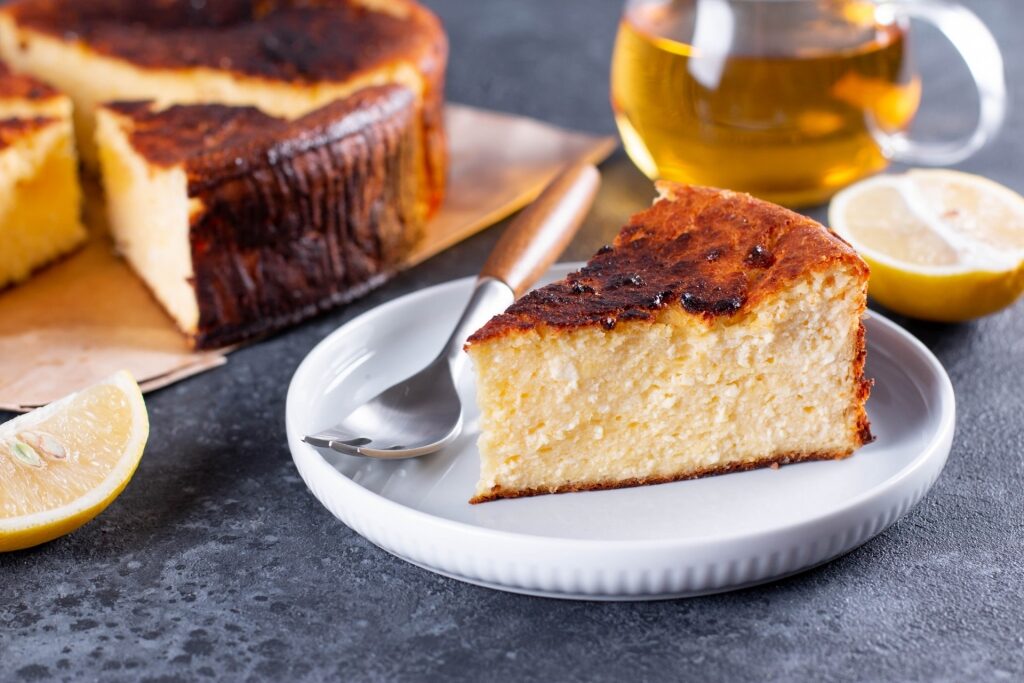
Greixonera de brossat
If you’re still searching for your daily sugar rush, you ought to give greixonera de brossat a try. Greixonera de brossat is Mallorca’s beloved cheesecake, made with fresh brossat, or requesón cottage cheese.
Brossat, cinnamon, eggs, and lemon zest are combined into a velvety mixture which is poured into a clay baking dish and baked. This cheesecake is then given a light sprinkling of cinnamon and sugar.
Greixonera de brossat is a classic Easter treat, although it can be relished throughout the year. Last but not least, this creamy cheesecake should be served chilled.
Llonguet
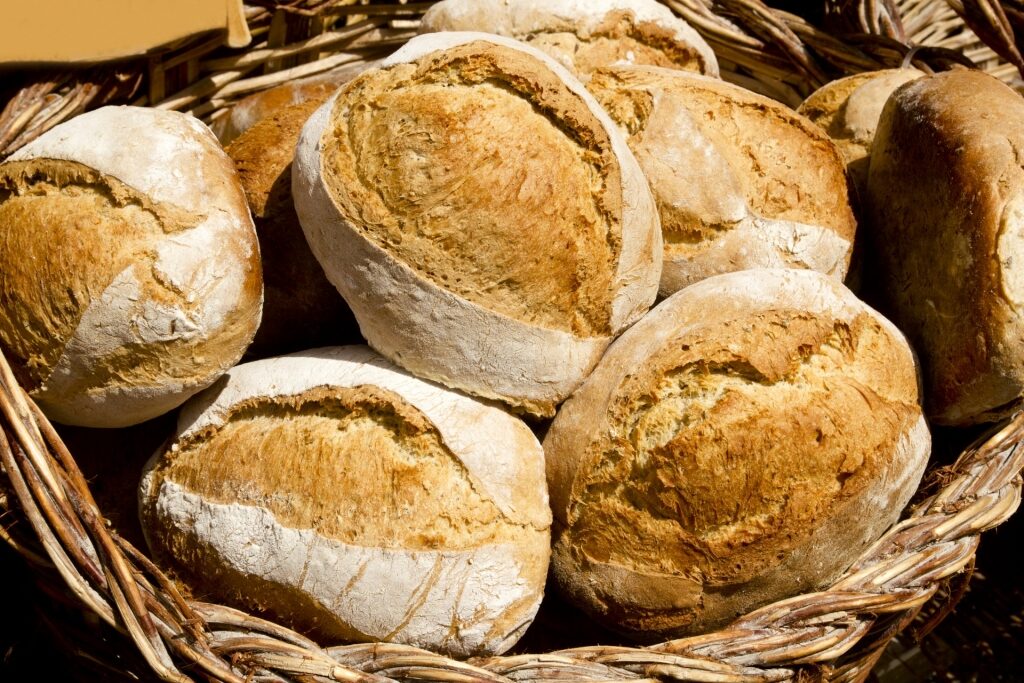
Llonguet
Crispy llonguet bread rolls are synonymous with Palma, one of the best towns in Mallorca. These baked bread rolls are great for making sandwiches and are exceptionally popular in Palma. Residents of the capital are sometimes even referred to as “longuets”.
You can get your llonguet with whatever filling you fancy, including jam, cheese, cured meat, and sobrassada.
Diehard fans of this bread roll can take part in La Ruta del Llonguet, usually held on Wednesdays during fall in Spain. This culinary route swings by some of Palma’s top bakeries, where you can sample different llonguet sandwiches along the way.

Palma de Mallorca
Discover the island’s wonderful gastronomic traditions by booking a cruise to Mallorca with Celebrity.
